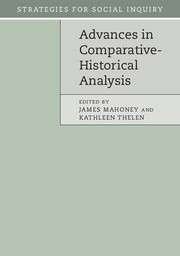Book contents
- Frontmatter
- Contents
- List of figures
- List of tables
- List of contributors
- Preface
- Part I Introduction
- Part II Agenda-setting work
- Part III Tools for temporal analysis
- Part IV Issues of method
- 8 The comparative sequential method
- 9 Nested analysis: toward the integration of comparative-historical analysis with other social science methods
- Epilogue: comparative-historical analysis: past, present, future
- Index
- References
9 - Nested analysis: toward the integration of comparative-historical analysis with other social science methods
from Part IV - Issues of method
Published online by Cambridge University Press: 05 July 2015
- Frontmatter
- Contents
- List of figures
- List of tables
- List of contributors
- Preface
- Part I Introduction
- Part II Agenda-setting work
- Part III Tools for temporal analysis
- Part IV Issues of method
- 8 The comparative sequential method
- 9 Nested analysis: toward the integration of comparative-historical analysis with other social science methods
- Epilogue: comparative-historical analysis: past, present, future
- Index
- References
Summary
In the decade following publication of the original edited volume, Comparative Historical Analysis in the Social Sciences (Mahoney and Rueschemeyer 2003), multimethod research became an important strand of comparative-historical analysis, which now warrants attention and reflection. Almost one-third of books published between 2003 and 2013 at leading university presses using comparative-historical analysis (CHA) also employ some form of quantitative analysis. In this chapter, I review the motivation for multimethod research and focus on a single variant, which I call “nested analysis.” I use that discussion as a point of departure for considering the possible integration of CHA with other forms of empirical analysis, including matching analyses and experimental methods.
The integration of multiple methods is not merely a defensive strategy to address the “few cases, many variables” critique that has long been leveled at canonical “small-N” comparative scholarship, such as Moore (1966), Skocpol (1979), Hall (1986), and Collier and Collier (1991). Mahoney and others have written extensively on the underappreciated leverage associated with the detailed over-time analyses contained in these seminal volumes and in CHA more generally (Gerring 2004; Lieberman 2001; Mahoney 1999). And Collier, Brady, and Seawright (2004) provide useful vocabulary with their notion of “causal process observations,” and contributors to their volume offered a balanced view to methodology in political science. Building on these strengths, the integration of methodological approaches has sought to leverage additional synergies for identifying causal mechanisms, addressing plausible rival explanations, and providing additional testable implications of central propositions. When done well, mixed methods research ought to substantially enhance the credibility of the social scientific claims being made.
My goal in this chapter is to review the prospects for successfully integrating CHA with other types of empirical methods, especially quantitative and experimental approaches. But before I proceed any further, let me make clear three key points that structure the discussion.
- Type
- Chapter
- Information
- Advances in Comparative-Historical Analysis , pp. 240 - 263Publisher: Cambridge University PressPrint publication year: 2015
References
- 9
- Cited by



